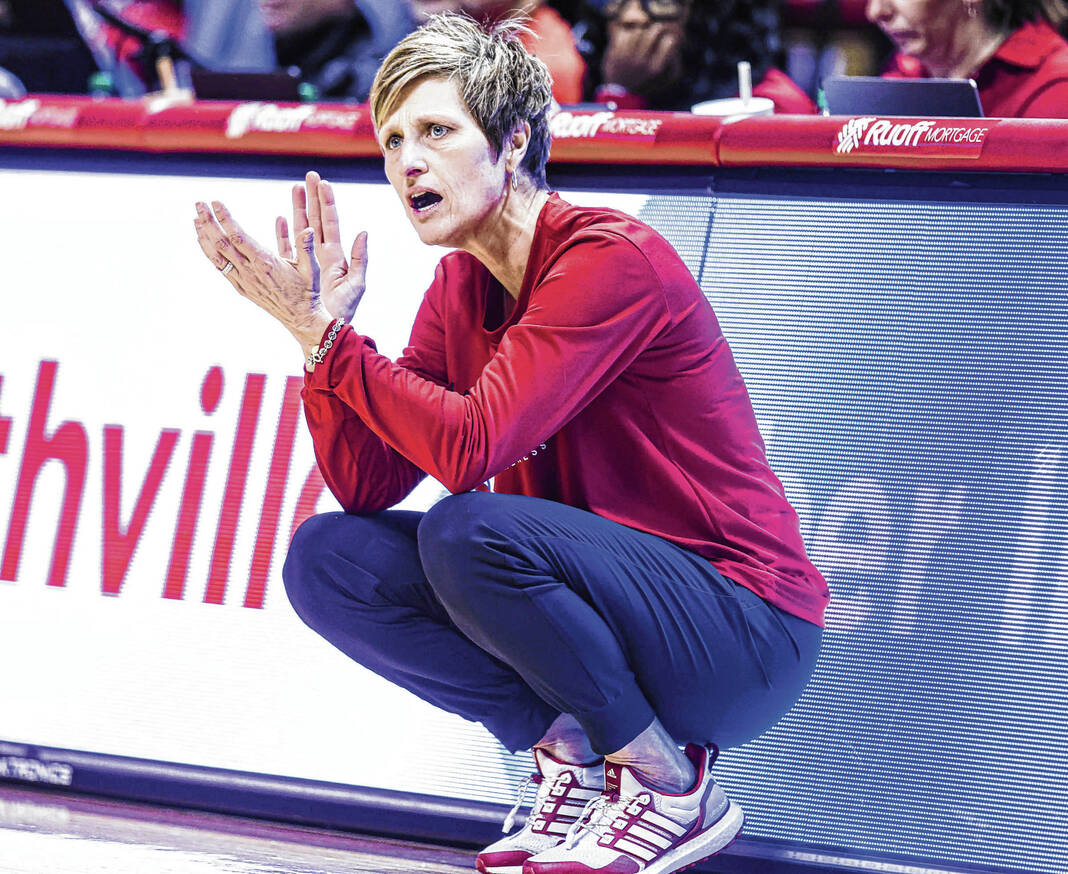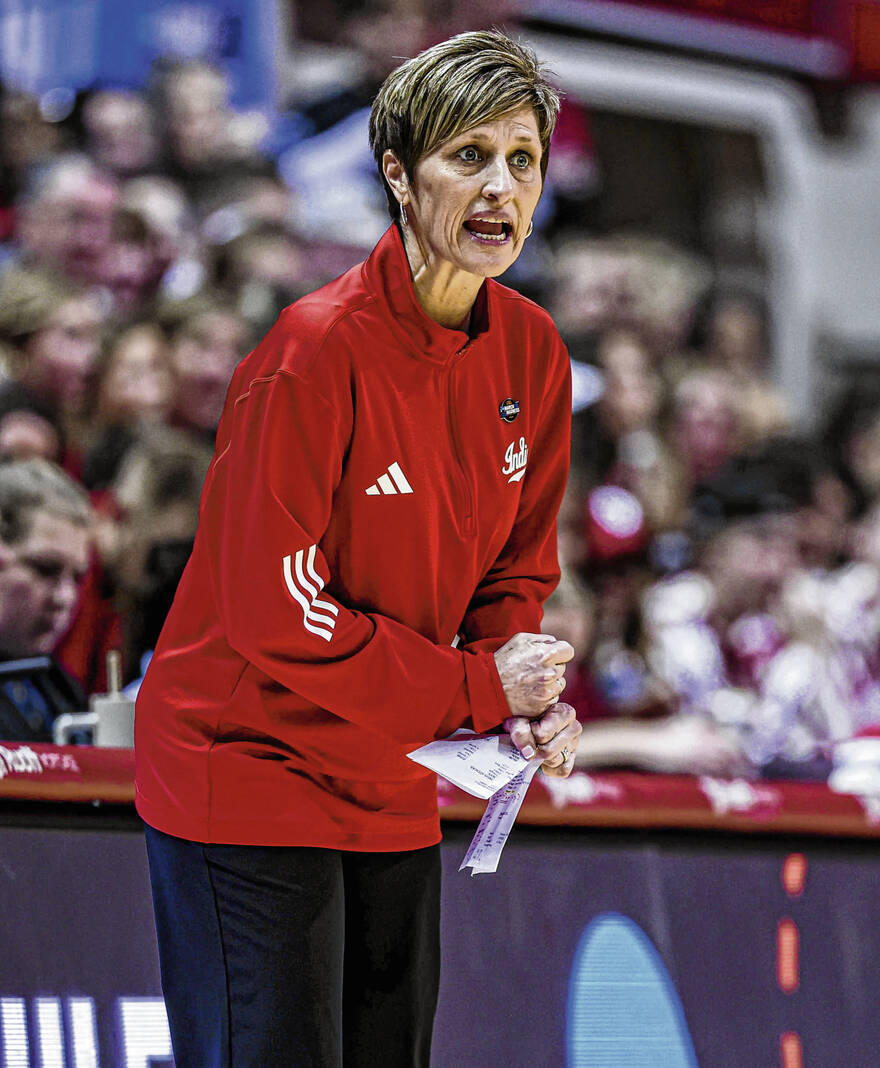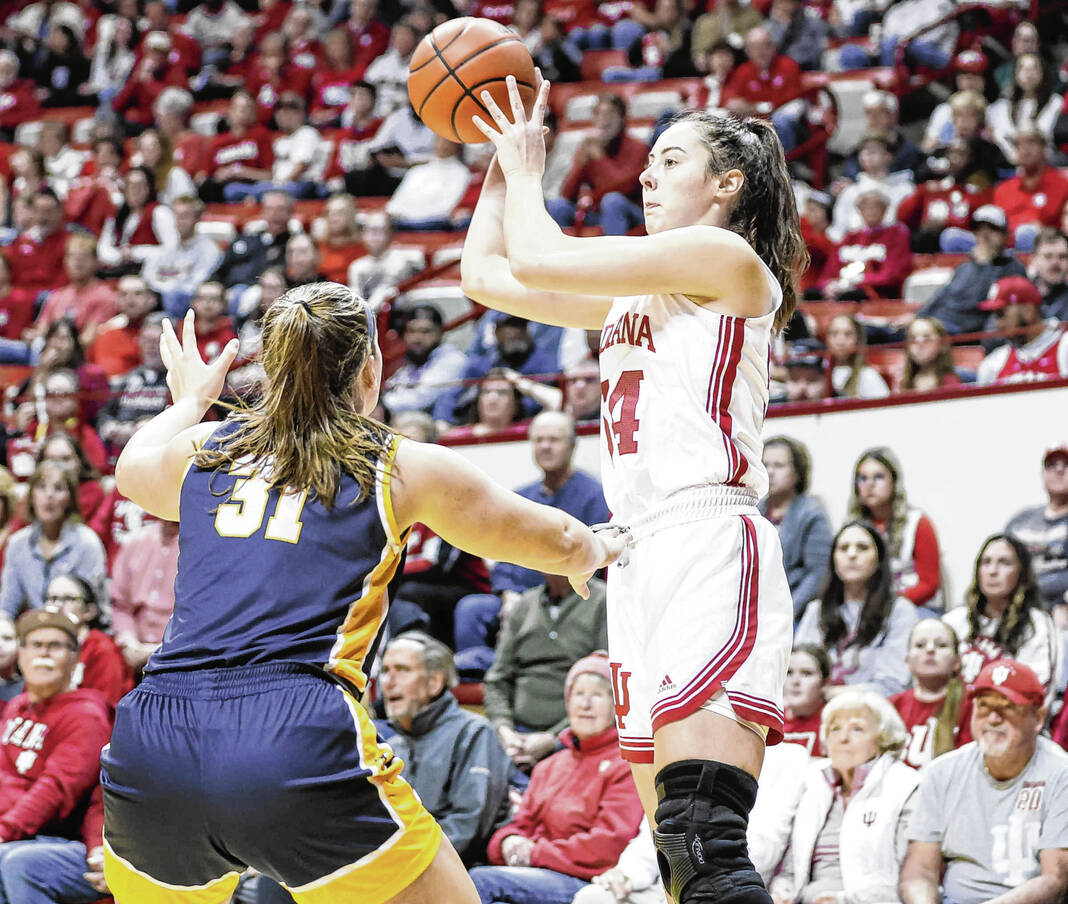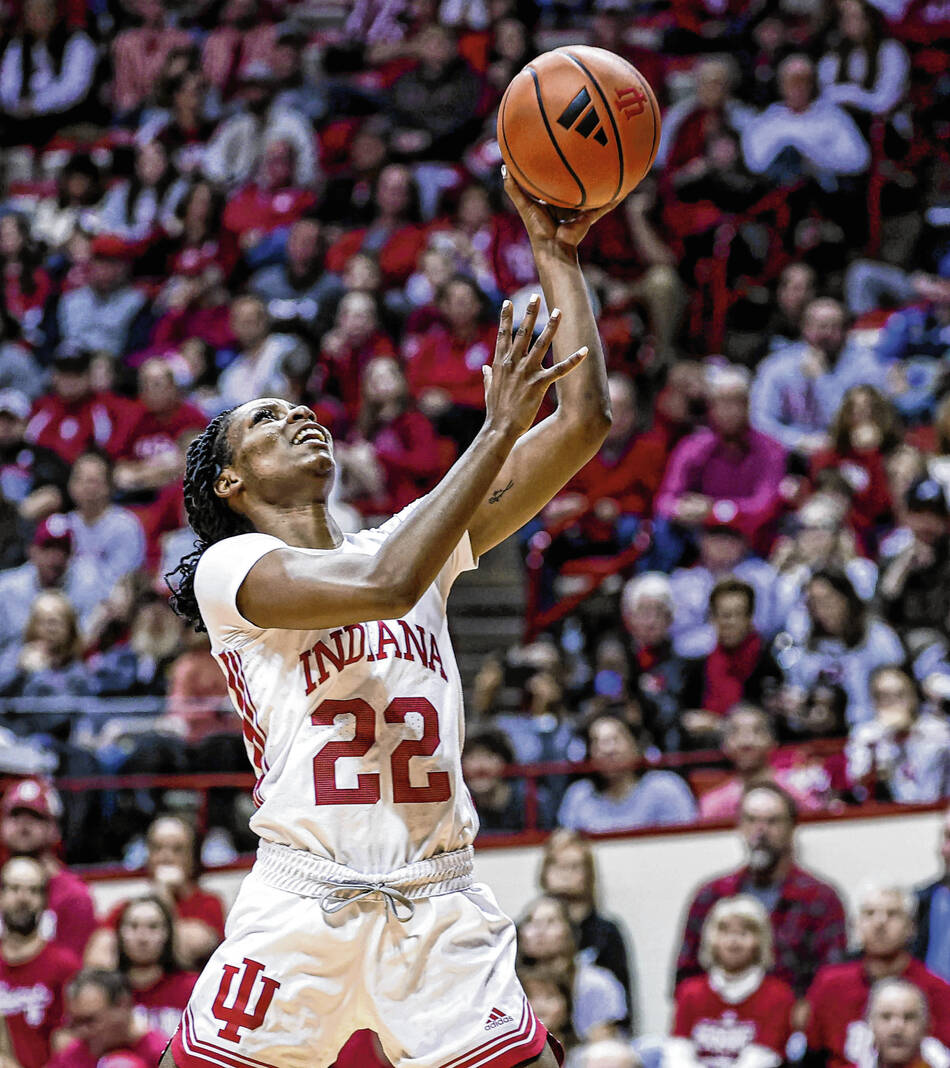
Former Seymour High star Teri Moren has built the Indiana women’s program into a national power.
Indiana University Athletic Department photo

Teri Moren has turned the Hoosier women’s team into a fixture in each spring’s NCAA tournament.
Indiana University Athletic Department photo

Mackenzie Holmes recently completed her IU career as the school’s all-time leading scorer and was drafted by the Seattle Storm of the WNBA.
Indiana University Athletic Department photo

Point guard Chloe Moore-McNeil will be back for her last year of eligibility for the Hoosiers during the 2024-25 season.
Indiana University Athletic Department photo
(From the college level to the pros, in Indiana, with Seymour women playing crucial roles, and around the nation, in person and on television, women’s basketball is reaching unprecedented heights of popularity propelled by Caitlin Clark and other new faces. The Tribune examines the developments in a four-part series.)
Evelyn Butler was a member of some of the first Indiana University women’s basketball teams during the early 1970s when the school advertised for players by tacking tryout flyers to walls on campus.
It was like a job ad saying “No experience necessary.” That was because many female students never had the opportunity to play the game before.
Compared to how female basketball players are now treated by IU, it was an extremely rudimentary way of life 50 years ago, the equivalent of sleeping on the hard ground in a tent versus traveling by luxury coach.
And speaking of travel, instead of flying by jet plane, the Hoosiers reached road games driving sport-utility vehicles. The players taped their own ankles before games without the aid of a trainer. Their uniforms did not come complete with basketball shoes. Instead, players visited a Bloomington sporting goods store to buy them.
“They let us go down and pick out a pair of shoes,” Butler said recently. “That was a big moment for us.”
Today, such treatment compared to the men’s team’s perks, would provoke players into filing lawsuits demanding gender equality under Title IX.
Today the IU women’s team under coach Teri Moren, however, is a national power, a fixture in the post-season NCAA. A decade into Moren’s tenure, the Hoosiers work out in their own modern practice facility and the Seymour native is paid $1.3 million a year to coach the squad.
Butler, 73, who served as a local supervisor of Big Ten officials for 38 years, is a first-hand witness to the old days when the Hoosiers were watched by perhaps “20 or 30 friends” at home games.
As part of an unprecedented boom in women’s basketball, during the 2023-24 season, IU averaged more than 10,000 fans per game at Assembly Hall, a first-time milestone.
Donna Sullivan, the current president of the Indiana Basketball Hall of Fame, was Moren’s high school coach in Seymour when she led the Owls to a semistate appearance in 1987. Sullivan said she was at Moren’s first IU-coached game and remembers there being only between 200 and 300 people in the stands.
“If you took a picture, you could count everyone in it,” Sullivan said.
Rarely a home game goes now without a Moren shout-out to the thousands of fans — who don’t all know the players personally — variously saying the team is “grateful” or “Hoosier nation showed up big.”
After the final home game of 2024, when the Hoosiers ousted Oklahoma in the second round of the NCAA tournament, Moren emphasized both thoughts before speaking about the game.
“Once again,” Moren said, “I just want to talk a lot about Hoosier Nation and them showing up tonight. It never gets old to say how grateful we are.”
Moren said almost the identical thing when IU won its first home game of the season in November over Eastern Illinois, which was her 400th career victory.
Also, as attention on women’s basketball continued to mushroom in nearly a repetitive refrain Moren said it was a terrific time to be a woman’s basketball player and a great time to be a woman in sports.
Moren played winning high school ball in Seymour and played for Lin Dunn, current general manager of the Indiana Fever when Dunn coached Purdue. Yet clearly, at 55, Moren’s memory is good enough to recall the in-the-shadows old days for women’s hoops.
IU now all grown up
The journey for women’s college basketball, IU women’s basketball and the building blocks laid by Moren to create a nationally respected program, has been a long, sometimes tortuous one.
While normal girls high school basketball is a staple of athletic programs across the country, for some years the menu option consisted only of a six-on-six style of play with just three women in the lineup allowed to cross half-court.
Butler played softball and field hockey, but not basketball, before suiting up for IU. She disdained the not-quite other hoops version. These days, with that background, Butler, who owed her sports interest to older brothers, might at best be a hoops team manager.
The highest level of college play is where Indiana sits, a winner of at least 20 games in a season for nine straight years under Moren, including 26 in 2023-24 and 28 the previous year, accompanied by a Big Ten regular-season crown.
Following her 11 seasons as head coach split between the University of Indianapolis and Indiana State University and the decade at IU, Moren’s record is 425-229, a 65% win rate. The Hoosiers captured a women’s NIT title in 2018, reached the Elite Eight of the NCAAs and twice recently the Sweet 16.
Moren declaring at the start of last season IU had the ability to win a national title and stressed winning it all is her goal. When she came to Bloomington in 2014, Moren said she wanted to emulate the admired men’s program which has won five national titles.
Tyra Buss, Amanda Cahill, Grace Beger and Mackenzie Holmes are among the top Hoosier players under Moren. Also, guard Sara Scalia, All-Big Ten this season, who just signed to play professionally in Italy.
Top core players Sydney Parrish, Chloe Moore-McNeil and Yarden Garzon, buttressed by new recruits, project another 20-win season in 2024-25
Holmes, a two-time All-American, just finished her IU career as the team’s all-time leading scorer and was a third-round draft pick of the WNBA’s Seattle Storm in April, though she is sitting out this season because of knee surgery.
Holmes, from Maine, said Moren’s sales pitch emphasized a culture and vision of success which she wanted to be part of and which came true. Following her final home game at Assembly Hall in March, Holmes led a thank-you team rush into the stands to mingle with fans, giving high-fives and hugs.
“I just want them to know how much I love them,” Holmes said. “They’re the best fans in the country and I’ve been blessed every second I’ve gotten to play in the Hall.”
Calling Assembly Hall her favorite place in the world, she said the memories created there “I’ll take with me for the rest of my life.”
Berger, a second-year guard for the Indiana Fever, is from Louisville. She said the IU culture changed over the span of her 2018-2023 career, with expectations to win and an Assembly Hall attendance expanding.
“Her determination to make this program be one of the best in the country year in and year out was evident, and hearing her talk, I had no doubts that she would do just that,” Berger said of Moren.
This past season, “The Caitlin Clark Effect,” now a slogan spelled out on T-shirts at Fever games, took hold in Bloomington when Iowa was scheduled to face Indiana on Feb. 22.
A year earlier, IU sold out Assembly Hall capacity of 17,222 seats for the first time in a win over Purdue. This time, the match-up with rival Iowa sold out a stunning seven weeks in advance.
When IU at last hit the ceiling on single-game attendance, the notoriously difficult-to-satisfy Moren acknowledged the occasion.
“Finally, this is what it should look like,” she said. “This is what women’s basketball should look like.”
The Grand Old Days with flaws
That is not what gymnasiums looked like when Butler competed for IU under the late Bea Gorton, who passed away at 73 in 2020. No such crowds sitting and standing applauding elbow-to-elbow.
Even as an embryonic program, IU was good enough to draw attention if more had cared about women’s basketball a half century ago.
IU went 79-28 under Gorton, reaching the Final Four of the Association for Intercollegiate Athletics for Women (AIAW) in 1973 and the Elite Eight in 1972 and 1974. Home court was the HPER Gym, originally opened for physical education in 1917.
Butler said some courts the early Hoosiers played upon were so small that out-of-bounds was considered the wall behind the baskets.
Although Butler remembers being second-fiddle to men’s teams coached by the late Bob Knight and forced to start practice late if the men ran overtime, Gorton said Knight was gracious and encouraging. When inducted into the IU Athletics Hall of Fame in 2014, she thanked him in her speech.
Moren said Gorton, who actually has a higher winning percentage at IU than her, played a significant role in Indiana women’s basketball history.
She called Gorton “a pioneer” and said her “dedication to our program in its early stages as a varsity program will never be forgotten.”
In some ways, though, they are. There are record gaps about those earliest teams such as no leading scorer listed in the media guide until the 1975-76 season.
It was a very different era, a big deal, Butler said, when the Hoosiers faced Immaculata College. These days, most fans would say, “Who?” But Immaculata, located near Philadelphia, won the first three AIAW national championships. IU was one of Immaculata’s victims in a title run.
In 2009, an inspirational movie called “The Mighty Macs” was released about the unbelievable hoops rise of the little religious school. It contains a Hollywoodish scene of nuns in their habit forming a vocal cheering section at a game. That was based on reality.
Laughing now, Butler said the viewpoint of Immaculata was, “They had God on their side.”
One omission of public acknowledgment of IU women’s basketball history rankles Butler. When all of the NCAA tournament success is discussed about Elite Eights and Sweet Sixteens to her it seems forgotten that Gorton’s IU bunch reached the Final Four, only in the AIAW.
“It makes me feel good that we did what we did,” Butler said. “Excuse me, I was on a team in the Final Four. It would be nice if we got recognized.”
Evelyn Butler would love to see a shiny new IU women’s AIAW Final Four banner hanging in Assembly Hall.
